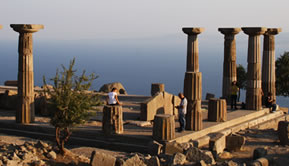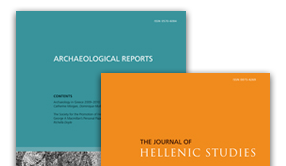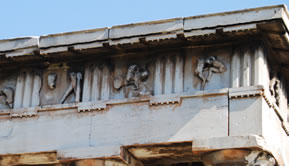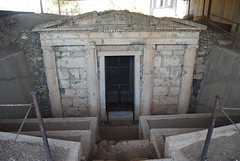Marking the Anniversary
Gonda Van Steen looks back at how the past three major anniversaries of the Greek War of Independence have been celebrated – and how those of 2021 might be different

Commemorative Medal 1830-1930 highlighting Greek territorial expansion
Since the outbreak of the Greek War of Independence in 1821, the Greek people have celebrated three major anniversaries: the 50th, 100th and 150th anniversary dates of the inception of the revolutionary war that led to sovereign statehood after nearly four centuries of Ottoman rule. These three jubilees, each with its own legacy, have come to represent three different ways of celebrating Greek statehood that have, nonetheless, much in common.
The celebrants considered the festivities to be in the best interests of the Greek state, and of its younger generations especially, but many ceremonies – and subsequent state rituals – displayed a more self-serving political culture or nationalist ideology as well. Up to 1971, the celebrations and reenactments, with their commemorative events and symbolic images, acquired a prescriptive character, which further advanced their aim to educate youth in state-promoted nationalism.
The bicentennial year of Greece’s Revolution invites us to study the earlier celebrations, their main themes and agendas, the imaginary nation to which they appealed, and the images and reports they left behind. Also, the various anniversaries offer up a potent reminder that, on each occasion, the nation’s process of becoming was yet to be completed.
The year 1871 preceded the Balkan Wars (1912–1913) and the ensuing territorial gains by a few (turbulent) decades. The crisis of 1921–1922 signaled a reduction in the Greek territorial expanse and an even greater blow to Greek political and cultural self-confidence. The year 1971, which fell about halfway through the dictatorship period of 1967–1974, was used by the military regime to affirm ‘revolution’ and ‘independence’, but by the anti-dictatorship opposition to question the extent to which the long-suffering state had been genuinely sovereign and democratic.
The Fiftieth Anniversary, 1871
The celebratory year of 1871, or the marker of fifty years since the Greek Revolution, was much anticipated. A few events raised the stakes in the lead-up to the anniversary year. Russia had been holding the relics of Ecumenical Patriarch Grigorios V (1746–1821), who, as the leader of the Orthodox Greek religious minority living under the Ottoman Empire, had been killed shortly after the outbreak of the Greek revolt. The Sublime Porte retaliated against the ‘traitors’ among the members of the Greek elite who served in prized clerical and administrative positions. It considered the then patriarch, despite his calls for caution and even for submission, to be one of them.
Upon his assassination, Patriarch Grigorios’s remains had been taken to Odessa. Half a century later, the Greek state arranged to have these relics brought home to the new nation and to rebury them, with due pomp and circumstance, in the Metropolitan Cathedral of Athens. The conspicuous involvement of King George I and Queen Olga marked the interment as a nationalist and Athenocentric occasion.
With sponsorship by George Averoff, the Greek state also arranged to have the patriarch’s honorific statue erected in front of the central building of the University of Athens. This statue was sculpted by Georgios Fytalis but was unveiled after a slight delay. As a religious symbol, the statue joined that of another ethnomartyr, Rhigas Velestinlis or Rhigas Feraios (1757–1798). The tribute to this precursor-champion of the revolutionary struggle was the work of sculptor Ioannis Kossos, who acknowledged Rhigas’s enlightened and secular political philosophy and also the postrevolutionary idealization of his person and aspirations. The two statues tied the revolution to the new institutions of the modern, nationalist Greek state, in particular to the University of Athens with its classicizing ethos.
In 1875, the statue of Adamantios Korais (1748–1833) was set up in the same general location, outside the central building of the University of Athens. Korais left a rich intellectual legacy to the Greek state. He had made his permanent home in Paris, where he shared in French Enlightenment theory and in radical thought. He laid the foundations of a Hellenic Library of editions of seminal classical texts, with which to instruct the younger Greek generations.
The concern for the younger Greeks’ education was a recurrent theme also in the subsequent anniversary celebrations. All of these initiatives exemplified the deliberate creation of new cultural and social beings in young (male) Greeks, who would cultivate patriotism. They came to be identified with the nationalist-didactic ideology of Korais as the revolutionary Greek expatriate who inspired many others. Use of Greek texts and monuments, of symbolic imagery and of a normative ideology in subsequent anniversaries, strengthened the classicizing ethos that the three statues of the 1871 jubilee had first come to embody. But the anniversary celebrations remained more limited in scope than, for instance, the broader nineteenth-century Greek impulse to organize knowledge and nationalism: knowledge about (and power over) the ancients and their artifacts began to overlap with the creation of national museums, printed collections, libraries, theatre stages and the educational infrastructure of the modern Greek state at large.
The three statues – of Rhigas Feraios, Patriarch Grigorios and Korais (in the chronological order of their making) – embodied the fusion of antiquity, Byzantium and the modern era (on the seminal nation-building model of Constantinos Paparrigopoulos). They also captured the power of religion to augment nation-building (and vice versa), as well as the potential of language and patrimony. Taken together and with the University of Athens as their backdrop, the statues showed the Greeks’ commitment to the blending of all these facets of the modern Greek nation. Thus, the 1871 anniversary celebration signalled an early call of achieved success, even though major struggles of religious integration, territorial expansion and defeat, linguistic debate and reform, and overall institutional (re)structuring still lay ahead.
Decades prior to 1871, the initiative had been raised to stage Greek history as a continuum of male athletic prowess inherited from antiquity and to strengthen national reawakening in that manner. In January 1835, Ioannis Kolettis (1774–1847), minister of internal affairs to King Otho, published a proposal (in French) for athletic games and festivals to commemorate, at public expense, the major events and battle sites of the 1821 War of Independence and also the spirit of national unification that its advocates had propounded. Thus Kolettis initiated a programme for a visual as well as a verbal rhetoric of the nationalist pageantry of continuity.
Kolettis’s programme underpinned many subsequent Greek celebrations, including the Zappas Olympics (1859, 1870, 1875 and 1888–1889). The 1896 revival of the Olympic Games was the most important catalyst to the Greek heroic pageantry of cultural continuity. Historicizing pageantry, tied to symbolic dates and locations, drew from the Enlightenment philosophy and the praxis of the French Revolution, which espoused the edifying value of mass public spectacles, dynamic bodies moving through dramatic spaces, ancient or ancient-style monuments, and the arts. In Greece, however, the heroic pageantry of continuity and syncretism acquired a life of its own and determined nearly all subsequent types of historical reenactments in the nationalist vein.
1921 Becomes 1930: A Centenary of the Revolution or of Nationhood
The aftermath of the First World War and Greece’s own political and military predicament prevented the year 1921 from being the celebratory centenary that it could have been. The Cretan statesman Eleftherios Venizelos (1864–1936) dominated the national and even the international scene. As prime minister of Greece and leader of a prolonged struggle against the royalist elite, Venizelos (ed: see further pp. x-x) travelled to Paris in 1919 to represent his country at the Paris Peace Conference. There, he secured Allied consent for Greece to occupy the region of Smyrna (Izmir) and its hinterland in Asia Minor. Venizelos then pursued the signing of the Treaty of Sèvres (10 August 1920), which postulated settlement terms between Greece and the Ottoman Empire and sanctioned the Greek occupation of Smyrna and its environs. Thus, he became the executor of Greece’s irredentist aspirations of the Great Idea. At the peak of his power, Venizelos was proclaimed the architect of ‘Greater Greece’, or of ‘Greece of the two continents and the five seas’. In mid-September 1920, he staged his partisan-patriotic victory celebrations at the Panathenaic Stadium (that is, the old Olympic Stadium or Kallimarmaro Stadium in downtown Athens). Venizelos’s own triumphal procession provoked reactions that ranged from uncritical adulation to shock and outcry.
Venizelos did not shy away from self-promotion and the relentless quest for patriotic prestige. After he lost the November 1920 elections, however, he temporarily disappeared from the Greek political scene. By 25 March 1921, the Greek army had suffered the first military setbacks in the battle against the new Turkish nationalist forces. The sense of danger, of loss and catastrophe, would soon be borne out by the Smyrna Disaster of mid-September 1922. The post-1922 era may have been ripe for a reconsideration of the irredentist Great Idea, but in March 1921 the time to rethink the propagandistic use of mass pageantry had not yet come. The year 1921 saw modest ceremonies that again honoured the revolutionary martyrs and offered up historical reenactments. Also, it prompted the erection of war memorials and the foundation or restoration of monuments and other prestigious public venues (such as the Herodes Atticus theatre). Venizelos again transformed the 1921 parade into a Venizelist rally, not unlike the triumphal procession of mid-September 1920. Thus, he tied the performative quality of military expeditions and parades to the spectacle of nationalist (self-) representation. Classicizing festival pageantry was mined for its political capital as well as for its cultural capital (to use notions established by Pierre Bourdieu).
The Turkish victory, the Greek rout and the Smyrna Disaster of September 1922 meant that the history of 1821 was being reversed, that the centenary of 1921 was soon unravelling. Venizelos’s grand scheme and the entire vision of the Great Idea collapsed in the ashes of Smyrna. The dream of the grand celebration of Greater Greece, of the final realization of the Great Idea, was crushed. The surviving ethnic Greek populations of Asia Minor were forced to leave for an uncertain future in Greece, which, as a country with very limited resources or infrastructure, had already been straining under the burden of prolonged war. It took Greece at least through the interwar years to recover. The consequences were deeply divisive politically and affected culture and commemoration as well. In another act of overreach, the Greeks postponed the big celebrations of their country’s centenary, to commence on the symbolic date of 25 March 1930. The delay of the centenary festivities was motivated by the once again unrealistic expectation of new gains to celebrate by 1930. This new centennial would honour the actual formation and recognition of the independent Greek state, which was founded in 1830.
When the grand centennial of 1930 came around, the atmosphere was still subdued in and around Athens, again the geographical centre-point of the festivities. Venizelos’s last administration of 1928–1932 oversaw the celebrations, which explains their self-congratulatory tone and ethos. Once more, politics, the military, religion and ideology blended together in mass spectacles of the state staging itself. Notably, the centennial recreated the Panathenaic Procession in an archaizing and nationalist spirit. Athena’s new peplos, however, was substituted by the Greek flag, which, according to plan, would be changed annually on top of the Acropolis, and each year a different Greek city or region would be responsible for this flag ceremony. Thus, archaizing public spectacle merged with the modern Greek demand for regional as well as national unification.
The Tomb of the Unknown Soldier on Syntagma Square, begun in 1929 and meant to deliver yet another symbolic message of moral strength and continuity, was, unfortunately, not ready to be unveiled in time (not until 25 March 1932). In 1930, too, Venizelos rededicated the bronze statue of the revolutionary war hero Kolokotronis, who had been imprisoned by King Otho’s administration, thus placing himself in a popular genealogy that was antiroyalist as well as revolutionary. The past had to infuse the present in an unbroken continuum of patriotic spirit and resiliency.
1971: The Self-Celebration of a Military Regime
The colonels of the dictatorship of 1967–1974 did not invent their parade festivals and athletic contests, but they made them their own by expanding and militarizing them. The architects of the latter regime’s events had before them a series of canonical templates and a performative repertory from which to choose in accordance with the prevailing state priorities. The strongmen of the coup of 21 April 1967 had certain technical advancements working for them as well. Thus, Georgios Papadopoulos propped up his public celebrations with ‘suitable’ (read: censored) television and other media coverage, whose rote praise was the illusionary equivalent of the rote applause in the Panathenaic Stadium. By 1971, the year of the 150th jubilee of the Greek Revolution, the dictators had sought and found an ‘authentic’ tradition of origins and a ‘valid’ genealogy for their own military intervention, their self-styled ‘regenerative Revolution’. The cult of the revolutionary past came to serve a cult of much-advertised new but undemocratic beginnings. The ‘Revolution of April 21, 1967’, was far removed from the kind of liberalizing sociopolitical reform that Greece badly needed.
Papadopoulos’s casting of the revolution of 1821 as a grand analogue for his own military aggression smacked of propagandistic distortion. The 150th anniversary of the revolution and the anticipated nationwide festivities were announced with a similar, hubristic degree of fanfare. The jubilee’s specific events were planned at a large meeting held in the Old Parliament, in September 1970. Papadopoulos himself gave the directions, but top officials of the political and ecclesiastical hierarchy participated as well. The attendees decided that the celebrations should last throughout 1971, which was named as the ‘Year of Hellenic National Freedom’.
For the dictators, the theatrical communication through displays of military culture was one of tradition, supremacy and proven authenticity. The junta relentlessly promoted the values of the country’s rulers, ancestors and roots by grounding them in a proud, ‘authentic’ history, in an unchanging geo-cultural territory and in linear, diachronic time. Moreover, the dictators presented the battles against interior and exterior communists of the past and present alike as interrelated parts of a single ‘holy war’ in defence of the nation. Their official rhetoric, bolstered by the protracted state of martial law, was rife with calls for ‘patriotic’ loyalty to the nation’s ‘protectors’ and for vigilance and suspicion of fellow Greeks.
In this way, the 1971 jubilee and other junta festivals emptied out or erased the past of the Civil War, especially, and the leftist sympathies and forces of resistance that lived on. Not surprisingly, the official rhetoric of ethnic pride and of the strong national family appealed to the patriotic sentiment of those Greeks who sought stability after many years of military and political turmoil. For some, the regime’s stagings of historical continuity were gratifying precisely because they were long familiar. Plenty of others, however, realized that the junta was reducing Greek valour to purebred military character—and, even then, more to muscle power than to military genius. More outspoken critics saw a farcical spectacle and a transparent concoction of propaganda.
The regime’s exaggerated displays of military prowess at the 1971 jubilee and on many other occasions were meant to (re)shape the people’s knowledge of Greek history and to inspire their pride for being ‘racial descendants’ of the ancient Greeks. Thus, the junta festivals picked up where the practice of school history lessons and their nationalizing mission had left off, teaching sacrifice-oriented ‘patriotism’ and conformism in the name of Greek continuity.
From the nineteenth and well into the twentieth century, instruction in Greek history in primary and secondary schools, preferably highly structured, was marked and marred by its relentless emphasis on the ‘patriotic’ national past. Ancient Greek language and literature, too, were often taught in tedious, ethnocentric ways, presenting the symbols of classical culture as sacred cows. For decades, ‘patriotism’ had been performed in Greek school teachings, in the teacher’s lecturing and in the student’s regurgitating of historical content that was to be idealized but never reinterpreted. The junta festivals joined traditional pedagogy in using youths and adults as prime material for nationalist subject formation.
To be sure, the nationalization of the masses through formal history lessons or through festivals that display the nation’s bodily performance or that invent national ‘traditions’ is a widely shared process in constructing modern nation-states. However, the Greek dictators’ manipulation of the past was an extreme case in the long course of the state’s appropriation of national history, whether through the official discourse that addressed the adult population, or through the poor teaching of history in the public school and university system.
Among the sharpest detractors of the regime’s spectacles were students and youth, who mocked all officialdom, its bombast, its victory festivals and military parades. They resented the artificial cultivation of ‘sound morality’, especially. Greek history’s heroes appeared as exempla virtutis in a morality play, out of touch with the progressive spirit and changing mores of the late 1960s.
The spectacle of 1971, too, instilled a rigid essentialism, which proved far removed from the fluidity of Greek history in 1821. The 1971 jubilee was a commemoration of the past; at best, it was a hypocritical legitimation of an undemocratic present. Its events did not leave any notable artistic or architectural legacies; they only affirmed past and outdated commemorative modes. The anniversary was detached from contemporary cultural developments as well as audiences and failed to look forward to a new era. Ever since the collapse of the dictatorship, the critiques of the misuse of history by the colonels and by other authorities have been more vocal. They have rallied against the historicizing and anticommunist pageantry, especially, which lasted through the early 1980s.
The productive but also troubled realm of Greek historical celebrations and of mass pageants has, for decades now, been central to the formation of Greek identity. For the greater purpose of instilling national sensibilities, the Greek state has put itself on display at landmark anniversaries. The performative dimensions of anniversary parades, with their typical sequences of heroic episodes through the canonical ages of Hellenic civilization, had to model proper ideals and modes of conduct for Greece’s young people, in particular.
Three major events have marked the nation’s celebration history of the outbreak of the War of Independence in 1821. The domestic political culture and ideology of the three major anniversary dates – namely 1871, 1921/1930 and 1971 – could hardly have been more different. Nonetheless, the execution as well as the objective of these jubilees of the past converged as they resorted to classicizing statues and mass pageantry to mark the Greek state’s public and formal use of history. Surveying these anniversaries may be a fruitful exercise in anticipation of a critical evaluation of the bicentenary of the year 2021.
The Greeks of the past three anniversaries had not yet reached a consensus about how to present recent Greek history, but many had come to realize that the true interest of the national past lay in how it constituted and conditioned the future. Their monuments and festivals served the national interest and also the goal of political cohesion; they projected the idea of progress along a historical and cultural continuum, and they posited a survival, revival, or even resurrection of a Greek patriotic ethos. The sustained continuity model that linked the past to the present was, undoubtedly, engaged in national mythmaking. Also, this model kept suggesting a paradoxical kind of parthenogenesis of Greek culture, as if Greek culture moved forward in a controlled vacuum, from one military victory to the next, and was only ever driven by male leaders.
Perhaps for the last time, the jubilee of 1971 tried to solidify a national master narrative that reasserted the political and socio-economic status quo. In hindsight, it failed to once more crystallize the national myth. Let us hope that, when we look back on the 2021 year-long celebrations, we see them build on a critical reception of the past jubilees. Let us hope that they will prove to be meaningfully different.












